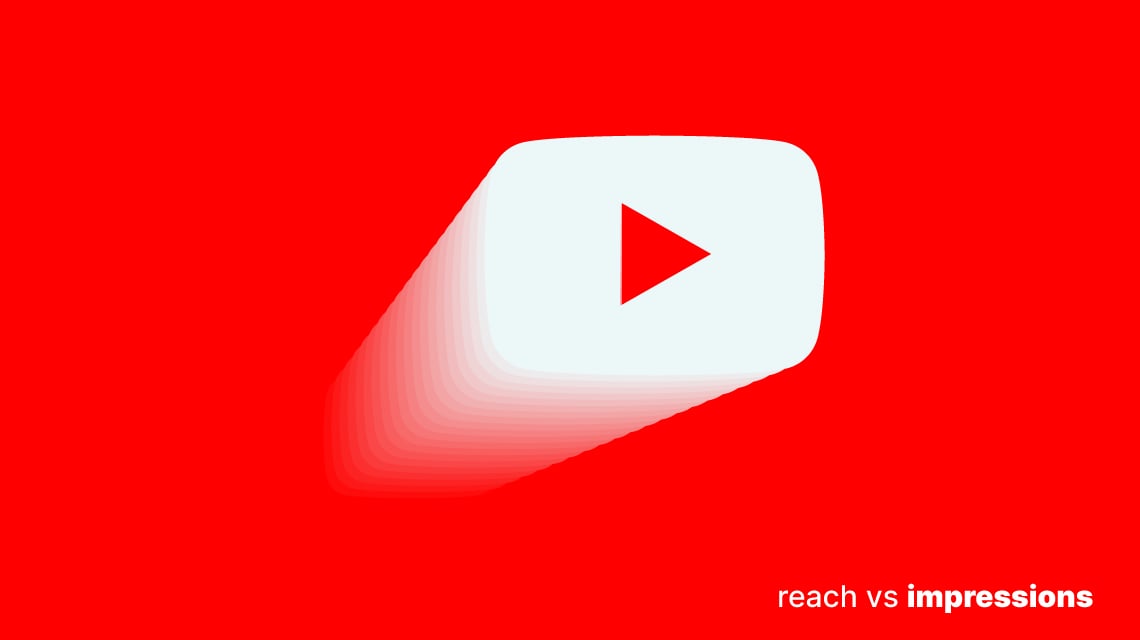YouTube has become a powerful platform for creators, brands, and marketers alike. One of the key metrics that often comes into play when analyzing performance is "impressions." But what does this term really mean, and how can it help you grow your channel? Let’s dive into the world of YouTube impressions to uncover what they are and how they’re calculated.
What Are YouTube Impressions?

At its core, a YouTube impression refers to the number of times your video thumbnail is shown to viewers on the platform. When someone scrolls through their feed and sees your video, that counts as one impression. It's like a handshake in the digital world—it's the first point of contact between your content and potential viewers.
To give you a clearer picture:
- Visibility: Impressions signify that your content is visible, but it doesn’t guarantee clicks. A high impression count with low views might suggest that your thumbnail or title isn’t enticing enough.
- Audience Engagement: Impressions help assess how well your videos catch viewers' attention, making it essential for audience engagement strategies.
- Performance Tracking: By tracking impressions over time, you can identify trends and patterns that inform your content strategy, helping you to refine your approach.
In summary, YouTube impressions are vital because they provide insight into how often your content is being seen. Understanding this metric can help you optimize your thumbnails, titles, and overall content strategy.
Also Read This: How to Block YouTube on a Chromebook: Managing Screen Time
How YouTube Impressions Are Calculated

Calculating YouTube impressions is not as straightforward as one might think. YouTube uses several criteria to determine what counts as an impression. Here’s a breakdown of how this calculation works:
1. Thumbnail Display: An impression is counted when your video thumbnail is displayed to a user. This can happen in various ways:
- In search results when a user types in a query.
- On the homepage, where YouTube recommends videos.
- In suggested videos that appear next to other videos.
2. User Interaction: Importantly, YouTube specifically counts impressions when the thumbnail is shown for more than a few seconds. If a viewer quickly scrolls past your video, that doesn't count as an impression.
3. Unique Views: Each unique viewer sees your thumbnail counts as separate impressions. If a user refreshes their feed and sees your video again, that adds more impressions.
To illustrate:
| Scenario | Impressions Counted |
|---|---|
| User sees your video on the homepage | 1 impression |
| User sees your video again in suggested videos | 1 additional impression |
| User scrolls past quickly | 0 impressions |
In conclusion, YouTube impressions are a reflection of your content's visibility. Understanding how they are calculated allows you to optimize your videos effectively. By focusing on engaging thumbnails and creating compelling titles, you can increase the likelihood of your impressions converting into views, leading to greater success on the platform.
Also Read This: How to Paste a Link in YouTube Comments for Easy Sharing
The Importance of YouTube Impressions for Content Creators
YouTube impressions are more than just a number; they play a crucial role in a content creator's journey to success. When your video gets an impression, it means that it has been shown to potential viewers in their feeds or search results. This initial exposure is vital, and here’s why:
- First Contact: Impressions are often the first point of contact between your content and a viewer. The more impressions you accumulate, the higher the chance that someone will click and watch your video.
- Algorithm Benefits: YouTube’s algorithm favors videos that generate more impressions. If your video starts getting more impressions, it signals to YouTube that people are interested, which can lead to even more visibility.
- Understanding Audience Engagement: Monitoring your impression data can provide insights into how different thumbnails, titles, and descriptions resonate with your audience. Are they intrigued enough to click? If not, it might be time to rethink your approach.
- Competitive Edge: In a sea of content, impressions can help you stand out. Videos with higher impressions are often favored in searches, making it essential for creators to strategize on how to maximize these numbers.
In summary, impressions provide a snapshot of how well your content is reaching its intended audience. For content creators, understanding and leveraging this metric can lead to improved engagement and, ultimately, channel growth.
Also Read This: Is SEC Network Available on YouTube TV? Here’s What You Need to Know
How to Increase Your YouTube Impressions
Ready to boost your YouTube impressions? Here are some practical strategies that can help your videos get noticed:
- Create Compelling Thumbnails: Your thumbnail is like a book cover; it needs to grab attention! Use bold colors, readable text, and intriguing images. For instance, if you’re creating a cooking channel, a bright, appetizing image of the finished dish can work wonders.
- Optimize Video Titles: Titles should be catchy and contain relevant keywords. Instead of “My Cooking Journey,” try “5 Quick Recipes for Busy Weeknights.” This not only explains the content but also helps with search visibility.
- Leverage Tags and Descriptions: Don’t overlook the power of tags and descriptions. Be sure to include keywords that people might search for. Think about what your target audience would type into the search bar.
- Engage with Your Viewers: Foster a community by responding to comments and asking for feedback. When viewers feel connected, they are more likely to share your content, leading to more impressions.
- Promote on Social Media: Share your videos across different platforms like Instagram, Facebook, or Twitter. Creating teasers or behind-the-scenes content can draw viewers in and spark curiosity.
Experimenting with these strategies can lead to a significant uptick in your impressions. Remember, increasing impressions takes time and consistency, so keep refining your approach and analyzing what works best for your channel!
Also Read This: Meet Mary Burke: Exploring the Life and Content of This YouTube Personality
5. Common Misconceptions About YouTube Impressions
When it comes to YouTube impressions, there are a few myths that can create confusion among creators. Let’s tackle some of the most common misconceptions to help you navigate this aspect of your channel more effectively.
1. More Impressions Equal More Views
Many people assume that if their video has a high number of impressions, it automatically means they’ll get a lot of views. While impressions are a good indicator of how many times your video was shown to potential viewers, they don’t guarantee that people will click on it. The real magic happens when your thumbnail and title grab attention!
2. Any Impression Counts
Not all impressions are created equal. An impression occurs when a video thumbnail is shown to a user, but for it to be impactful, it needs to be presented in a context where the viewer is likely to engage. For example, being shown in an irrelevant search result might not be as beneficial as being featured on a trending page or suggested videos.
3. Impressions Are the Only Metric That Matters
While impressions provide valuable insight into how often your video is being presented, they’re not the only metric to focus on. It’s crucial to analyze other factors like view duration, audience retention, and engagement rates. These metrics tell you how well your content resonates with viewers once they click through.
4. Impressions Are Static
Another misconception is that impressions are a fixed number that remains constant. In reality, impressions can fluctuate based on various factors, such as changes in YouTube's algorithm, your content's relevance, and seasonal trends. Regularly checking your analytics will give you a clearer picture.
5. Impressions Are Only About New Videos
Many creators believe that impressions only apply to newly uploaded content. However, older videos can continue to gain impressions as they are recommended or searched for by users. This means that a great video can keep bringing in impressions long after its initial release!
6. Analyzing Your YouTube Impressions Data
Now that we’ve debunked some myths, let’s dive into how you can analyze your YouTube impressions data to enhance your channel’s performance. Understanding this data is key to refining your content strategy.
1. Accessing Your Analytics
To begin analyzing your impressions, head to YouTube Studio and navigate to the Analytics section. Here, you’ll find a dashboard filled with metrics, including impressions, views, and click-through rate (CTR). The impressions panel will show you how many times your video thumbnails were displayed to users.
2. Interpreting Click-Through Rate (CTR)
Your CTR is a vital metric derived from your impressions. It tells you the percentage of impressions that led to views. A low CTR might indicate that your thumbnails or titles need improvement. Aim for a CTR of around 2-10%, but remember that this can vary by niche.
3. Comparing Impressions Over Time
Look at how your impressions change over time. You can compare different videos or track the performance of one video across weeks and months. This will help you see if certain topics or formats attract more interest. For example, if a video on a trending topic garners significantly more impressions, consider creating more content in that vein.
4. Location and Traffic Source Breakdown
Understanding where your impressions come from is crucial. Are they from YouTube search, suggested videos, or external sources? This insight can guide your promotional strategies. If a large portion comes from YouTube search, optimizing your video titles and descriptions for SEO should be a priority.
5. Adapting Based on Insights
Once you have analyzed your data, it’s time to adapt your approach. Implement changes based on what the data tells you. If certain thumbnails consistently lead to higher impressions and CTR, use that style as a benchmark for future videos.
By thoughtfully analyzing your YouTube impressions data, you can tailor your content more effectively and foster a growing audience. Remember, the key is to keep experimenting and learning!
 admin
admin








